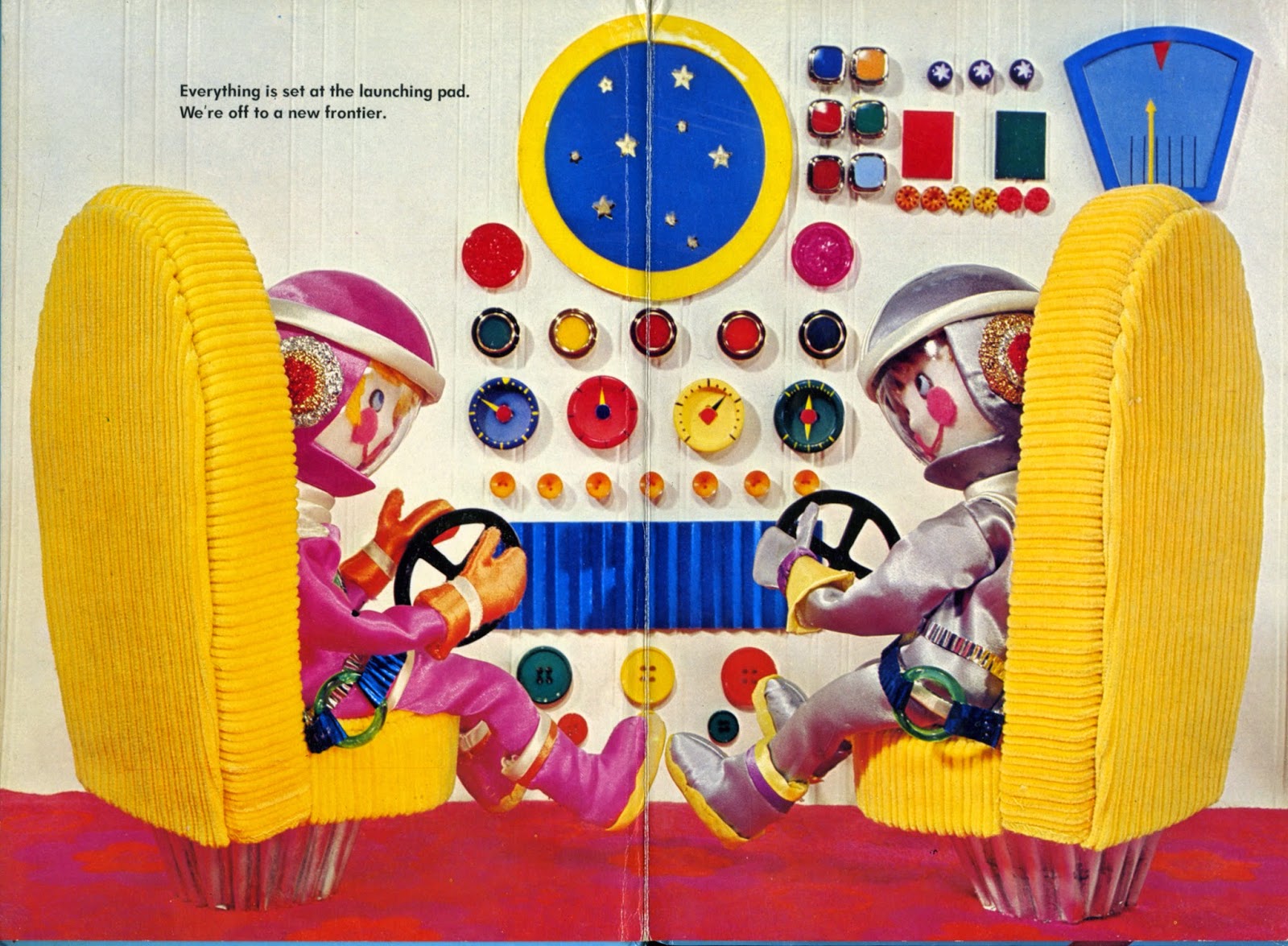Friday, August 29, 2014
Astronauts (1961)
Toys in Space #5
A beautiful punch-out book from the height of the space race.
Astronauts: Exciting, accurate punch-outs ready to assemble: Including Redstone Rocket, Ground Control Center, Launching the Atlas, and Recovery of the Astronaut. (1961) What more do you need to re-enact your own space program?
I like the astronauts and ground crew very much. The astronauts all seem to express personality and you get to choose who goes up first and who works Ground Control.
My favorite of this set is my "desk jockey action figure". He and the people like him were the heroes of those early days. While the astronaut was just "spam in a can" they had to monitoring second by second this risky ballistic flight (well technically they did make orbit).
Notice the "view wheel" so you could simulate what it was like to look at the capsule control panel (window) while you were up in space.
Friday, August 22, 2014
Machines in Space (1973)
Toys in Space #4
This one is literally pictures of space toys. I really enjoy how it connects children imagining what their (your) toys are doing while they (you) play with them with the actual jobs of people exploring space. It looks like a translation or reprinting of a japanese book based on its style and approach.
Froebel. Machines in Space.[Place of publication not identified] : Froebel,1973. 13 p.
Friday, August 15, 2014
Project Go!: Big space punchouts for little astronauts (1963)
Toys in Space #2
A bit of a re-run. I finally re-scanned this item
http://dreamsofspace.blogspot.com/2013/10/project-go-big-space-punchouts-for.html
so you could appreciate the punch-outs. In some ways this is kind of silly but
They do include this "model" of a delta winged spaceship very similar to those being tested at the time. It also reinforces the military aspect of spaceflight development and testing.
The designation X-1-7 puts this particular rocket firmly into the ranks of it's sibling test rockets.
I am not convinced the flying saucer assembly had anything to do with the space theme expect it was easy to build.
Friday, August 8, 2014
Blast Off (1980)
Toys in Space #1
Rose Art Studios.; Abisch, Roz. Blast off. New York : Mulberry Press, 14p. 27 cm. 1980.
A Mulberry adventure puppet book.
Tuesday, August 5, 2014
America's Explorers in Space (1967, 1969)
This is one of the first space books I owned. I had other books before 1967 but somehow this one was very memorable. There are lots of used copies out there because of this reprint:
Which was distributed on behalf of Disabled American Veterans. I am not sure how they happen to be involved with distributing this book. Perhaps people could make a donation and have this book donated in their name to their local school or library.
Cox, Donald W. Illustrated by Dobbins, Dwight. America's Explorers of Space (including a special report on UFOs). Maplewood, NJ: Hammond Inc. (93 p.) 26 cm. Cloth, DJ.
and the 1969 edition:
Cox, Donald W. Illustrated by Dobbins, Dwight. America's Explorers of Space (including a special report on Project Apollo) (2nd edition). Maplewood, NJ : Hammond Inc. (93 p.) 27 cm. Cloth, DJ.
A biographical encyclopedia with biographies of 16 men involved in the history of space exploration including Robert Goddard, Chuck Yeager, Virgil Grissom, and John Glenn. ). Last section of book focuses on UFO's. (pp. 74-87). The 1969 edition was updated with a new text section on Project Apollo (pp. 74-87, replacing 1st edition's UFOs section) and a new sub-title.
1967 Table of contents
1969 Table of contents
I find it very interesting that along with the biographies of space explorers they chose to have UFOs highlighted in the the 1967 edition. UFOs feel very unscientific from almost 50 years later but they may have thought that the biographies would be too dry without some "sensation."
I appreciate that they included not only astronauts but some of the people who were important in creation our theories and tools of space exploration. Usually these people were not highlighted.
Although the reprint has a 1969 date it must have been rushed out in the latter half of 1969 to take advantage of the publicity of a Moon landing. The section on Apollo has very complete coverage of the Apollo 11 trip to the Moon.
Subscribe to:
Posts (Atom)










































